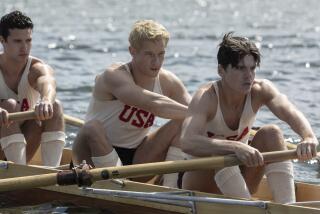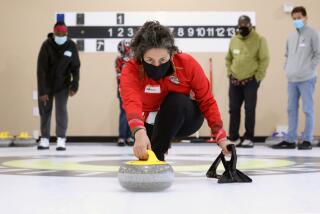Rowing propels Griebenow to scholarship
- Share via
Every weekday afternoon, amid the joggers, bicycle riders and sailors of Marina del Rey, Erika Griebenow spends close to three hours with 90 other teenage boys and girls trying to master her newest passion: rowing.
The senior at Mira Costa High drives from Manhattan Beach to the Marina Aquatic Center, then experiences an adrenaline rush powering a 60-foot boat up and down Ballona Creek with seven teammates using synchronized strokes.
“There’s no taking it easy in a race,” she said. “You’re putting every bit of strength into every single stroke. You’re out there wanting to pull not only for yourself to get across the finish line but pulling for everyone in the boat that has worked just as hard as you have. It’s one of the best feelings at the end of the race. You’re exhausted and absolutely excited at the same time.”
Fifteen months ago, Griebenow was a high school volleyball player who had played six years of club ball. After taking a one-week beginner’s course in rowing, she abruptly dropped volleyball.
“What sold me was being out on the water,” she said.
Then came a startling discovery: Colleges wanted to pay for her education through rowing.
“I was really shocked when I found out I could get a scholarship,” she said. “I heard it could happen, but when I got those first couple of calls over the summer from coaches, I got so excited and couldn’t believe it was actually happening.”
Football schools, trying to compensate for the inequities in athletic scholarships for women, have been adding women’s rowing as an intercollegiate sport. There are 85 Division I women’s rowing programs, with Oklahoma the latest football power to add rowing, joining the likes of Michigan, Ohio State and Notre Dame.
Eight schools in the Pacific 10 Conference have rowing programs, including USC and UCLA. Schools can offer a maximum of 20 scholarships, and even if a scholarship isn’t awarded, students are finding that rowing can help gain entrance into the Ivy League.
“The demand for high school athletes coming into college at a high level has gone up dramatically,” said Zohar Abramovitz, coach of the Marina Aquatic Center junior rowing program.
From last year’s MAC varsity eight, girls were admitted to USC, UCLA, Stanford, MIT and Pennsylvania, and two from the JV team were picked up by other rowing schools.
On Wednesday, while the focus of many will be on those high school seniors who sign early letters of intent in such sports as basketball, baseball, softball and volleyball, the 5-foot-9 Griebenow will sign with California, which ranks with Brown as one of the top women’s rowing programs in the country.
“She’s got a lot of athletic ability that translates well into rowing,” Abramovitz said. “She’s tall, has long limbs, natural strength and has the willingness to push herself, which is really what rowing is all about.”
Students at the Marina Aquatic Center pay $3,000 to participate in rowing activities from September to June. That covers coaching, equipment and travel expenses. Besides Marina del Rey, there are junior rowing programs in Long Beach and Newport Beach. Races are held in October and November and in the spring, culminating in regional and national championships.
Before parents start urging their daughters to rush into rowing in attempt to receive a college scholarship, they better understand what it involves.
“It’s a huge commitment and a lot of hard work and not for everybody,” said Griebenow’s mother, Tina. “It’s physical work. It’s pretty grueling, but she loves it.”
Griebenow’s father, Larry, played volleyball at UCLA, and her younger brother, Chris, is a freshman water polo and volleyball athlete at Mira Costa. Chris watches what his sister endures and isn’t about to tease her about getting up on Saturdays at 6 a.m. to go racing.
“He sees how exhausted I am at the end of the day,” Griebenow said. “If I’m really sore, he’ll mess with me being a little brother. But he’s like, ‘No way am I going to do that.’ ”
It’s the rowing machine, known as the erg, that leaves athletes in agony.
“I just want to break it in half after a workout because I’m so tired, but I know it’s really good for me,” Griebenow said. “It’s the best workout I can get off the water.”
The erg score can help earn a rower a college scholarship, according to Abramovitz, because “you can get a pretty good sense of a rower’s natural ability and their overall strength and mental toughness by having them row on the machine.”
Griebenow’s score tells recruiters that she can pull 2,000 meters in 7 minutes 26 seconds. It helped her get a scholarship, but more important, she has come to love the sport.
“It’s an amazing feeling being able to go with everyone and have so much power,” she said. “It gives you a sense of control in the water, being able to master and move the boat.”
--
--
latimes.com /sports
Pulling it all together
Mira Costa senior Erika Griebenow discusses how her love for the beach, water and competition led her to the sport of rowing.
More to Read
Get our high school sports newsletter
Prep Rally is devoted to the SoCal high school sports experience, bringing you scores, stories and a behind-the-scenes look at what makes prep sports so popular.
You may occasionally receive promotional content from the Los Angeles Times.







